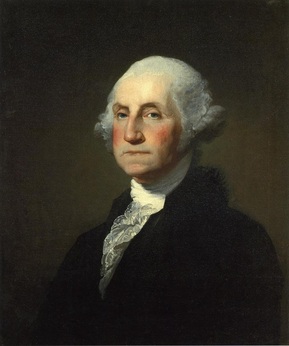 George Washington: 34 years of cannabinoid growing
George Washington: 34 years of cannabinoid growing The Cannabis Papers: A citizen’s guide to cannabinoids (2011)
By Publius
George Washington’s Cannabinoids
George Washington was born 22 February 1732; he grew his first cannabinoids, fields of hemp, at the age of 33 in the year 1765 – eleven years prior to the American Revolution.
Washington first grew pot in 1765 for the King (there was a hemp bounty) and harvested 5,000 pounds … of fiber; he also collected and processed 152 bushels of cannabis seeds his first year. He noted all of this 250 years ago in his farm notes; Publius discusses George’s hemp in The Cannabis Papers, essay #11, Washington’s hemp seed love.
Washington’s 283rd birthday and 34 years of growing cannabinoids are celebrated with four 2015 research articles from the National Institutes of Health (PubMed). Today’s cannabinoid update highlights: epilepsy and FAAH cannabinoid competition, pharmacoresistant epilepsy in children and CS treatments, our medical community in need of cannabinoid science, and further evidence of CS neuroplasticity (this time it’s the hippocampus).
Happy Birthday George!
And thanks for We the People ~ We Shall Dream Again!
I. Epilepsy, Fatty Acid Amide Hydrolase (FAAH) and Cannabinoid Competition
“Δ9-tetrahydrocannabinol (THC) and cannabidiol (CBD) occur naturally in marijuana (Cannabis) and may be formulated, individually or in combination in pharmaceuticals such as Marinol or Sativex. … Recent reports suggest that CBD and THC elevate the levels of the endocannabinoid anandamide (AEA) when administered to humans, suggesting that phytocannabinoids target cellular proteins involved in endocannabinoid clearance. Fatty acid binding proteins (FABPs) are intracellular proteins that mediate AEA transport to its catabolic enzyme fatty acid amide hydrolase (FAAH). … Competition for FABPs may in part or wholly explain the increased circulating levels of endocannabinoids reported after consumption of cannabinoids. These data shed light on the mechanism of action of CBD in modulating the endocannabinoid tone in vivo and may explain, in part, its reported efficacy towards epilepsy and other neurological disorders.”
Fatty Acid Binding Proteins (FABPs) are Intracellular Carriers for Δ9-Tetrahydrocannabinol (THC) and Cannabidiol (CBD).
Elmes MW, Kaczocha M, Berger WT, Leung K, Ralph BP, Wang L, Sweeney JM, Miyauchi JT, Tsirka SE, Ojima I, Deutsch DG.
J Biol Chem. 2015 Feb 9. pii: jbc.M114.618447. [Epub ahead of print]
PMID: 25666611 [PubMed - as supplied by publisher] Free Article
Related citations
II. Pharmacoresistant Epilepsy in Children and Cannabinoids
“Medications are often first-line treatment for epilepsy in children. A detailed review of antiepileptic drugs and their application in various epilepsy syndromes is provided in the article "Antiepileptic Drugs-A Review" by Sankaraneni and Lachhwani (this issue). Here, we will focus on nonmedicinal approaches-some fairly longstanding and described since Biblical times such as the ketogenic diet while others are relatively new such as neurostimulation. Yet, others such as cannabinoids have been utilized for centuries for their medicinal properties, but we are just learning the scientific basis behind their efficacy. Families are often interested in nonmedicinal avenues of treatment, and knowledge of these options can empower a pediatrician to help families make choices that have scientific validity.”
Options for pharmacoresistant epilepsy in children: when medications don't work.
Sharp GB, Samanta D, Willis E.
Pediatr Ann. 2015 Feb 1;44(2):e43-8. doi: 10.3928/00904481-20150203-11.
PMID: 25658218 [PubMed - in process]
Related citations
III. Medical Community Needs Cannabinoid Research
“There is growing interest in the therapeutic potential of marijuana (cannabis) and cannabinoid-based chemicals within the medical community and, particularly, for neurological conditions. This interest is driven both by changes in the legal status of cannabis in many areas and increasing research into the roles of endocannabinoids within the central nervous system and their potential as symptomatic and/or neuroprotective therapies. … Despite the widespread publicity about the medical benefits of cannabinoids, further preclinical and clinical research is needed to better characterize the pharmacological, physiological, and therapeutic effects of this class of drugs in movement disorders.”
The therapeutic potential of cannabinoids for movement disorders.
Kluger B, Triolo P, Jones W, Jankovic J.
Mov Disord. 2015 Feb 4. doi: 10.1002/mds.26142. [Epub ahead of print]
PMID: 25649017 [PubMed - as supplied by publisher]
Related citations
IV. Further Evidence of Neuroplastic Role of Cannabinoids (Hippocampus)
“Endocannabinoid receptors CB1R and CB2R are present in the CNS and modulate synaptic activity. … Results show that long-term hippocampal slice cultures respond to both CB1R activation and inactivation by changing neuronal protein expression patterns. In the present study, we demonstrate that CB1R agonist ACEA promotes alterations in the neuronal cytoskeleton as well as changes in CB1R expression in organotypic hippocampal slice cultures, and that CB1R antagonist AM251 promotes neuronal death and astroglial reaction.”
Further Evidence for the Neuroplastic Role of Cannabinoids: A Study in Organotypic Hippocampal Slice Cultures.
Caltana LR, Heimrich B, Brusco A.
J Mol Neurosci. 2015 Feb 3. [Epub ahead of print]
PMID: 25645684 [PubMed - as supplied by publisher]
Related citations
Today’s video: The surprising story of medical marijuana and pediatric epilepsy | Josh Stanley | TEDxBoulder
Next Ew Publishing: The beginnings of a Hannah Arendt series on Tuesday, 24 February, with The Human Condition, Arendt Footnotes and The American Revolution ~ monthly on the Bryan William Brickner Blog.
Posted by Bryan W. Brickner
 RSS Feed
RSS Feed
